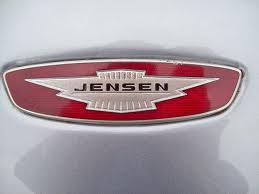


This edition of the Jensen CV8 FF 6.3L V8 is the 3 speed / Auto version and was first brought out in 1965. This was at around the same time as the introduction of the 1965 Aston-Martin DB6 1965 and the 1966 AC Cobra 427.This particular Jensen CV8 has a 6286cc Naturally Aspirated Petrol powerplant with 8 cylinders in a V formation.
The CV8 shares its Petrol V8 engine configuration with the likes of the 2023 Dodge Challenger SRT Demon 170 and the 2023 Ferrari SF 90 XX Spider 4.0 V8 Turbo. If you're looking for other fast cars which share the CV8's All Wheel Drive, Hatchback combination then how about the or the .
Weighing in at 1594 kgs (3514 lbs) this makes the Jensen CV8 FF 6.3L V8 in the same weight category as the 2022 Porsche 911 Carrera T 3.0 Turbo PDK 992 or the give or take 50kg.
In terms of power the 6286cc 16V V8 engine produces 330 bhp (246 kW) @ 4600 rpm similar to the 2024 Mazda CX-90 S 3.3 Turbo (340 bhp) or the 2023 Porsche Cayenne Coupe 3.0 V6 Turbo (348 bhp).
The Naturally Aspirated V8 throws out 425 lb-ft (576.2 Nm) @ 2800 rpm placing it with cars of similar torque performance figures such as the 2024 Ford Mustang Dark Horse 5.0 V8 (418 lb-ft) or the 2023 Porsche Cayenne S 4.0 V8 Turbo (443 lb-ft).
If one combines the weight with power or torque performance for the Jensen CV8 you can get a better idea of it's real world performance.
![Audi A4 RS4 Avant 2.7T Quattro V6 - [2000] image Audi A4 RS4 Avant 2.7T Quattro V6 - [2000] image](/editionimages/103.jpg)
The 2000 Audi A4 RS4 Avant 2.7T Quattro V6 (232.0 bhp per ton) has similar Bhp Per Ton stats as the Jensen CV8.
The Jensen CV8 has a Power to weight ratio of 207.0 bhp per ton and 266.6 lb-ft per ton. Bhp Per Ton figures of the 1965 CV8 competing with the 2000 Audi A4 RS4 Avant 2.7T Quattro V6 (232.0 bhp per ton) or the 1996 Subaru Impreza WRX Type RA - Classic JDM (231.9 bhp per ton).
If you agree with the late great Carroll Shelby then arguably an even better indicator of potential performance, Torque. Use weight as well and you end up with - Torque per ton, with the Jensen CV8 generating around 266.6 lb-ft per ton. If you're curious as to what other cars have as much torque to weight then look no further than the 2022 Lamborghini Urus Performante Twin Turbo (291.6 lb-ft per ton) or the 2013 Porsche 911 Turbo 991 (291.6 lb-ft per ton).
With a 0-60mph time of 6.70 secs or a 0-100km/h (0-62mph) of 6.9 secs, this made the Jensen CV8 FF 6.3L V8 as fast as the 2020 Ford Puma ST 1.5 Turbo (6.70 secs) the 2017 Maserati Levante 3.0 V6 Diesel (6.70 secs) the 2012 Dodge Charger SXT Blacktop 3.6L V6 (6.70 secs) the or the 2012 Abarth 695 Edizione Maserati 1.4 Turbo (6.70 secs). This Jensen CV8 FF 6.3L V8 is also faster than the 2017 Dodge Charger SXT AWD 3.7 V6 (6.80 secs) the 2015 Renault Megane Energy TCe 205 GT 1.6 Turbo (6.80 secs) the 2012 Mini Cooper John Cooper Works Countrman (6.80 secs) the and the 2010 Alfa-Romeo Brera JTS 3.2 V6 24v (6.80 secs).
When talking about the performance of the Jensen CV8 on the drag strip it can reach a quarter mile in an estimated 13.44 secs @ 101.8 mph. Similar performance down the quarter mile can be found with the the 2009 Mercedes E Class 500 Sport (13.38 secs), the 2007 Toyota Aurion TRD 3.5 V6 Supercharged (13.38 secs), and the 2021 BMW 2 Series M240i xDrive Cabrio 3.0 Turbo F23 (13.38 secs).
Modern performance cars are often artificially restricted to 155mph. The 1965 version of the Jensen CV8 FF 6.3L V8 has a maximum speed of 129mph.
If maxing out your car on the AutoBahn is your thing and you're wondering what's faster than the 1965 Jensen CV8 FF 6.3L V8 then how about the 2021 BMW i4 M50 (140 mph), the 2020 Abarth 695 70th Anniversario 1.4 Turbo (140 mph), or the 2019 Tesla Model 3 Standard Range Plus (140 mph).










Bugatti Centodieci 8.0L W16 64 Valve Turbo
Engine: Turbo Petrol | 7993cc 64v W16
Top Speed: 236 mph
0-60mph: 2.30 seconds

Maserati Indy Tipo 116 4.1 V8
Engine: Naturally Aspirated Petrol | 4136cc 16v V8
Top Speed: 225.3 kph
0-100kph: 7.4 seconds



















